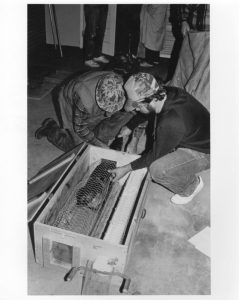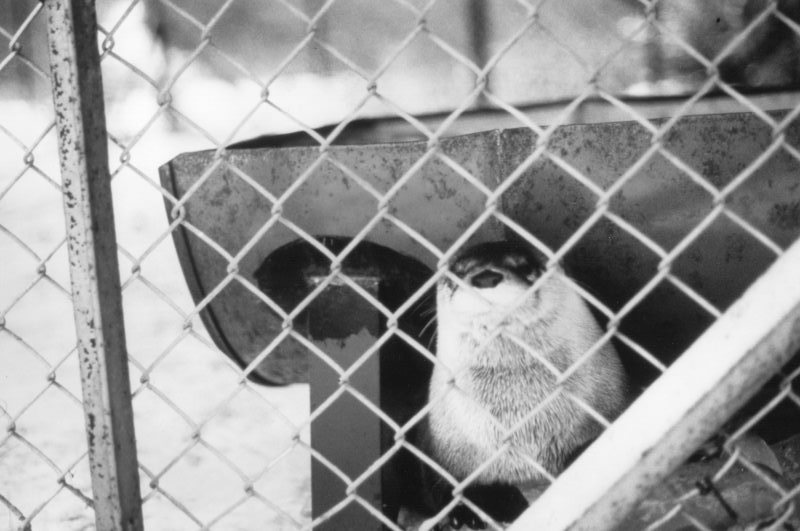ONTARIO OTTER FOR MISSOURI by B.M. 1984
The state of Missouri needs otter and the province of Ontario wants wild turkey. No problem. Ontario has otters, Missouri wild turkey. The solution is simple. Ontario and Missouri will trade otter for turkey. Otter for Rebel’s Cove, Missouri and wild turkey for Simcoe, Ontario. The turkey didn’t get off to an auspicious start for in the first shipment there were nothing but hens. And turkey are not hermaphroditic. However, since then that has been rectified by the arrival of some toms. As for the otter – no problem.
Karen Bellamy of the Ministry of Natural Resources (MNR) co-ordinated the Bancroft live otter trapping program. In July she approached Verne Cannon, a trapper from Maynooth, located just north of the village of Bancroft. Would Verne be interested in trying to live trap otter?
“I thought it would be a real challenge,” said Verne, “so I said sure, I’ll try anything once.”
Cannon was out west when the MNR had a briefing session on live trapping otter. “Maybe that was good,” said Cannon. “Having to rely on my own experience and knowledge forced me to try my own methods. I might have not done it my way if I had attended that meeting.”
Cannon had to wait for his traps that were in Huntsville being reinforced. The otters had proven to be so strong that they were escaping from the first traps used.
Cannon knew that otter travelled in pairs, as a family or mother and young. And so he set his traps in pairs near each other. He camouflaged the traps which resemble a chain link suitcase with marsh hay, the perfect material as it leaves little to no scent (otter’s have sensitive noses). Otters are accustomed to marsh hay, it’s light and doesn’t interfere with the operation of the trap.
Cannon finished checking his traps at 2:30 p.m. No otter. That evening he met with Bellamy and a trapper, Ted Coad, brought in from Alberta by the ministry. Ted had live trapped otter for four years. Maybe he could help. Following the meeting it was arranged that Karen, Coad and Cannon would tour Verne’s traps the next day.
“I didn’t know if he (Ted) was trying to be nice and make me feel better or not,” said Cannon. “We had checked 7 sets and nothing. Ted liked my sets and told me that all I needed was for an otter to come along and I’d catch one. I wasn’t so sure. I mean he’s the expert from out west. He must have wondered who let me loose in the bush. I sure was nervous.”
Cannon would have been pleased to catch one otter. We used to call it “saving face” in our mental health classes. But it didn’t look good. There was but one trap left to check. Verne had his waders on and continued upstream. The others kept to the bush trying to stay dry. As Verne got closer to the trap he could see an otter. “Hey, I’ve got one!” he yelled. Then he saw two heads. “I’ve got two!”
“You’ve got three!” shouted Bellamy.
“Their heads were popping up and down so fast I couldn’t tell for sure,” said Cannon. But there were three.
Verne was supposed to give the otter an injection to quieten them down but because they move so quickly he was afraid of injecting the same otter twice. Instead he cut some marsh hay to cover the trap. The otter pulled the hay in to make a nest. Next a rain suit followed by Verne’s coat covered the trap in darkness which proved to calm them. Placed in the back of a truck, the trap covered in more hay to quieten any noise, the otter were moved to some holding pens at Algonquin Park.

“Five river otter were received from the Province of Ontario on Friday, November 9, 1984.
Otters were processed that night in Kirksville and four were released on Saturday, November 10. One young-of-the-year male otter died of unknown causes, undoubtedly related to handling and drugging. Otherwise, the release went smooth. Two males and two females were released, an adult and juvenile of each,” read the Missouri Department of Conservation memo.
Three of the five came from Bancroft District; the other two from Chapleau. What makes this story unusual, perhaps unique, is the fact that three otter were found in one trap. And, the adult was male, not female as might be expected. The other were juveniles, one of either sex. Seasoned live trappers from such diverse locales as Louisiana and Alberta have rarely found two otter in a trap; never three. This may be one for the “Guinness Book of Records!” Certainly it’s a Bancroft first.
At $250.00 per otter Mr. Cannon has profited well by his years of experience, knowledge and ingenuity while at the same time contributing to conservation by helping to re-establish the Missouri otter in the Rebel’s Cove area. The monies for otter come from the Missouri Wild Turkey Fund.
While the first five otter were winging their way south another paid a visit to Cannon’s Hancock live trap. Now it and another from Chalk River also reside at Rebel’s Cove. Missouri was so pleased that it sent Verne a sweating stating “Otter-Bring Me Back to Missouri.”
Photos are courtesy of Brenda Penak, MNR, Queen’s Park who co-ordinated the otter program for all of Ontario.
GAME PRESERVE POACHERS
Mention deer hunting and the Peterborough Crown Game Preserve (PCGP) in one breath and you have all the elements necessary for a heated debate between hunters and antis. Mention poachers and both groups come together to share a common opinion.
During the recent deer season hunters reported poaching in the preserve and contributed to the successful apprehension of at least two poachers. Vigilant MNR Conservation Officers caught at least 5 more law breakers.
As a result one man was convicted and fined $1500.00 for night hunting and $500 for possession of a firearm in the PCGP. A second poacher, caught dragging a deer, was fined $750 and sentenced to 30 days in jail for escaping lawful custody. Five charges are pending regarding unlawful possession of deer in the preserve. The boys in green have been very busy.
